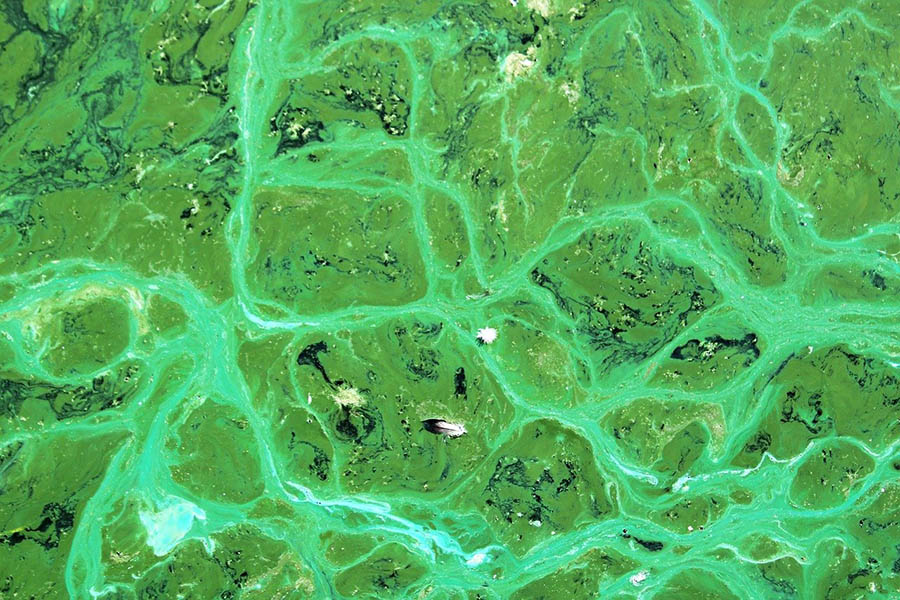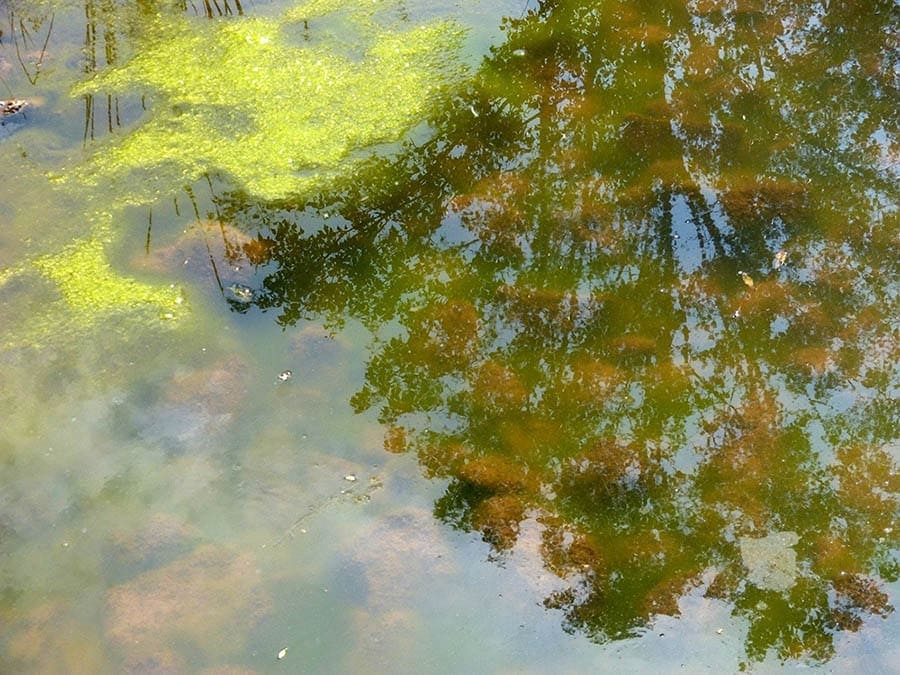If you are trying to manage algae growth in your pond, you know it’s somewhat of a nightmare to control. If you aren’t familiar with certain types of algae, you won’t know how to treat it, and you might not know that some can be toxic if ingested.
Let’s look at the different types of algae, how to purify your water, and keeping it algae-free.

The 6 Types of Pond Algae
1. Cyanobacteria Algae

Cyanobacteria, also called Cyanophyta, is a grouping of Gram-negative bacteria. This bacteria contains internal membranes called thylakoids, which aids in the process of photosynthesis. As this cyanobacterium grows, it causes algal blooms to form.
These dangerous algae release toxins which are known as cyanotoxins. Cyanotoxins are incredibly dangerous to animal and human life, infecting ecosystems, swimming areas, and drinking water.
If you’ve ever been to a lake with warning signs up, you might have read to watch for cyanobacteria—it is hazardous to swim in water that might be affected.
2. Chara Algae
Chara, also known as stonewort, is a type of algae that mimics plant life on land. They grow in stalks with leaf-like appendages. If you touch the plant in the water, it can feel grainy and slimy. However, it quickly dries out once it’s on land, turning firm and ashy.
It serves as a nutritious food source for birds and aquatic animal life. It also serves as a hiding place for little fish to scurry away in the face of danger.
While you might like the charm and appeal that it adds to an ecosystem, you might not prefer it to grow in your own pond. There are ways to remove this plant if you choose to—or if you feel like it has taken over your pond’s floor space.
3. Spirogyra Algae
Spirogyra is the type of algae you see collecting on smaller ponds during the spring and summer months, but eventually, it dissipates. Sometimes, it can take over ponds, ranging across the entire surface of the water. This algae is harmless and even healthy for wildlife if it’s not too invasive.
Spirogyra is a genus of over 400 floating green algae plants. It is some of the most common algae you will see traditionally. One exciting thing about this type of algae is that it can reproduce both sexually and asexually, meaning there are two different reproductive potentials.
The interior of the stems has a watery-filled portion called a vacuole where the nucleus is stored. Asexually, they reproduce by fragmentation. Sexual reproduction only happens in dire circumstances when the survival of the algae is at risk.
4. Golden Algae
Golden algae, formally called Chrysophyceae, is typically a freshwater growth, though it can occur in other conditions. It makes the water take on a rusty to mustard-colored hue—and it can be very dangerous if it comes into bloom.
Golden algae is a single-celled organism, but it can go through a period of rapid growth development. When it spikes, it can last for weeks at a time, doing real damage. It releases toxins that can be fatal to fish and other aquatic life in the area.
While wildlife management often tries to control the growth of golden algae, it is still possible in most freshwater situations.
5. Nitella Algae
Nitella is a charophyte in the green algae family. This algae typically starts growing alongside the edges of ponds and lakes. Once it starts to gather enough oxygen, these plants can surface. Like its Chara cousin, this plant resembles rooted terrestrial plants.
In the United States, there are over 30 species of Nitella, all of which have the same general appearance. Nitella is harmless in all forms but might be an eyesore for some.
6. Filamentous Algae
Filamentous algae form rather uniquely, webbing together to make a veiled colony. They form what is similar to threading, and if you were to touch it, it might feel like a mesh or sponge-like texture. Usually, this algae prefers to grow on rocks or other hard objects in the water, but sometimes it may detach.
Even though this algae is totally harmless, it doesn’t provide any nutritional value for wildlife. However, it does add environmental benefits to the pond—like being a habitat for tiny organisms.
So, if you don’t want to have it in your pond, there are ways to remove it when it decides to crop up—but it’s a very hands-on approach involving lots of raking to remove the mats.

How to Prevent Algae Growth
Algae can provide a layer of protection and a nutritious snack to pond life. There is no way to remove algae from your ponds completely—and some growth is even healthy. But if you want to cut back on developing aquatic growth, here are some tips for you.

Start growing floating plants
Floating plants, like lily pads and lotuses, will shade the water to starve potential algae growth. It prevents light from penetrating the water, feeding life.
Treat your water
There are tons of water treatment options to cut back on unwanted algae and other debris. Be careful about the treatment’s harshness, and always make sure that it’s the right one for your water.
Use UV Clarifiers
Ultraviolet clarifiers use a very intense light filtration system to purify the water, eliminating algae overgrowth.

Final Thoughts
Knowing the types of algae (and what they look like) can help you stay proactive if a little growth control is needed. Also, it’s helpful to spot dangerous algae so you can keep people and pets away from potentially hazardous water.
If you need to reduce a little algae, put a few tactics in place to discourage algae growth in your pond.
Featured Image Credit: Pixabay
